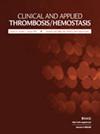中高危急性肺栓塞患者中性粒细胞与淋巴细胞比率、血小板与淋巴细胞比率与风险分层指标和血栓负担的相关性及治疗后的变化
IF 2.3
4区 医学
Q2 HEMATOLOGY
引用次数: 0
摘要
目的探讨中高危急性肺栓塞(APE)患者的中性粒细胞与淋巴细胞比值(NLR)、血小板与淋巴细胞比值(PLR)、风险分层指标以及血栓负荷之间的相关性,并评估介入治疗后这些指标的变化。方法本研究回顾性纳入了2020年5月至2024年5月期间莆田市第一医院介入血管外科收治的中高危APE患者。所有患者均接受了抗凝治疗、肺动脉导管引导溶栓和/或机械取栓术。如果患者在入院时没有出现以下情况,则进一步分为 A 亚组:a) 急性炎症性疾病(包括肺部感染);b) 恶性肿瘤;c) 在过去 2 个月内有外伤或手术史。结果A亚组的NLR和PLR明显低于B亚组(P< .01)。与健康对照组相比,APE 组和 A 亚组的 NLR 明显更高(P < .001)。肌钙蛋白 I 阴性组和肌钙蛋白 I 阳性组之间的 NLR 和 PLR 没有明显差异(P > .05),N-末端前 B 型钠尿肽(NT-proBNP)阴性组和 NT-proBNP 阳性组之间也没有明显差异(P > .05)。NLR和PLR与风险分层指标和肺动脉栓塞指数无明显相关性(P > .05)。与治疗前相比,NLR、肌钙蛋白 I、NT-proBNP、右室直径/左室直径比值和肺动脉栓塞指数在治疗后明显降低(P <.05),而 PLR 在治疗前后无明显差异(P >.05)。然而,NLR 与风险分层指标或血栓负荷之间没有相关性。PLR在评估APE方面没有显示出重要价值。本文章由计算机程序翻译,如有差异,请以英文原文为准。
Correlation Between Neutrophil-to-Lymphocyte Ratio and Platelet-to-Lymphocyte Ratio with Risk Stratification Indicators and Thrombus Burden in Patients with Moderate-to-High Risk Acute Pulmonary Embolism, and Changes After Treatment
ObjectiveTo investigate the correlation between neutrophil-to-lymphocyte ratio (NLR), platelet-to-lymphocyte ratio (PLR), and risk stratification indicators as well as thrombus burden in patients with moderate-to-high risk acute pulmonary embolism (APE), and to assess the changes in these parameters following interventional therapy.MethodsThis study retrospectively included patients with moderate-to-high risk APE who were admitted to the Department of Interventional Vascular Surgery at Putian First Hospital from May 2020 to May 2024. All patients received anticoagulation therapy, pulmonary artery catheter-directed thrombolysis, and/or mechanical thrombectomy. Patients were further divided into subgroup A if they did not present with any of the following conditions at admission: a) acute inflammatory diseases (including lung infections); b) malignant tumors; c) history of trauma or surgery within the past 2 months. Patients with any of the aforementioned conditions were classified as subgroup B. Additionally, 50 healthy individuals were randomly selected as the healthy control group.ResultsThe NLR and PLR in subgroup A were significantly lower than those in subgroup B ( P < .01). Compared with the healthy control group, the NLR in the APE group and subgroup A was significantly higher ( P < .001). There were no significant differences in NLR and PLR between the troponin I-negative and troponin I-positive groups ( P > .05), or between the N-terminal pro-B-type natriuretic peptide (NT-proBNP)-negative and NT-proBNP-positive groups ( P > .05). There were no significant correlations between NLR and PLR with risk stratification indicators and pulmonary artery embolism index ( P > .05). Compared with before treatment, NLR, troponin I, NT-proBNP, right ventricular diameter/left ventricular diameter ratio, and pulmonary artery embolism index were significantly reduced after treatment ( P < .05), while there was no significant difference in PLR before and after treatment ( P > .05).ConclusionElevated NLR in patients with APE, which decreases after effective treatment, may be used for assessing disease status and treatment efficacy. However, there is no correlation between NLR and risk stratification indicators or thrombus burden. PLR does not demonstrate significant value in assessing APE.
求助全文
通过发布文献求助,成功后即可免费获取论文全文。
去求助
来源期刊
CiteScore
4.40
自引率
3.40%
发文量
150
审稿时长
2 months
期刊介绍:
CATH is a peer-reviewed bi-monthly journal that addresses the practical clinical and laboratory issues involved in managing bleeding and clotting disorders, especially those related to thrombosis, hemostasis, and vascular disorders. CATH covers clinical trials, studies on etiology, pathophysiology, diagnosis and treatment of thrombohemorrhagic disorders.

 求助内容:
求助内容: 应助结果提醒方式:
应助结果提醒方式:


